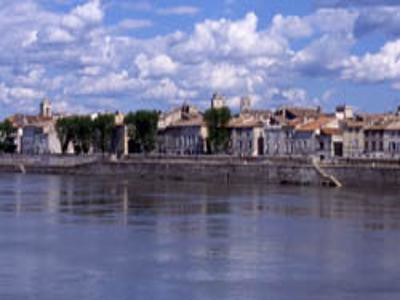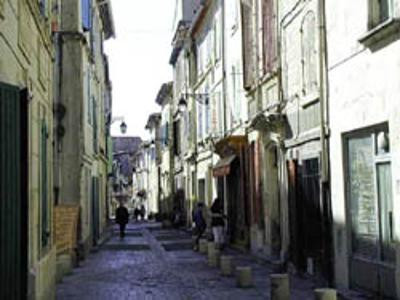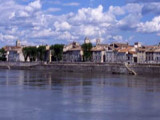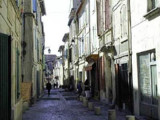The District of la Roquette
Historic site and monumentPresentation
The Roquette district, which emerged in the Middle Ages and was long a favorite haunt of bargemen, remains one of the city's most picturesque.
The town's original fishbone pattern of narrow, often high-rise houses stretches between the Quai du Rhône and Boulevard Clemenceau. The facades, rich in architectural decoration, and the numerous niches adorning the street corners, attract the eye and invite you to stroll.
The district was also bustling with craftsmen and merchants, and was home to a number of prominent families who left beautiful townhouses.
After a decline triggered by the disappearance of the inland waterway industry in the 19th century, the district is now enjoying a spectacular revival, with numerous restorations (La Roquette is in a protected area) and the establishment of stores and businesses in its eastern part, giving it a new lease of life.
Its population, 2,427 in 2006, a legacy of the district's past and recent history, is particularly heterogeneous: social classes, generations and diverse cultural origins mingle to give it a village feel.
Remains of the 16th-century rampart
After the troubled retreat of the early Middle Ages, Arles underwent a period of renaissance from the 10th century onwards, gradually moving beyond its walls. In the first half of the 12th century, a veritable district was created to the southwest of the city, the Vieux-Bourg, now known as La Roquette.
Its lordship belonged to the Porcelet family, whose fortress stood on today's Place Antonelle.
With its oven, mills, churches and ferry across the river, it quickly established itself as an entity quite distinct from the original quarters of the Roman colony. Soon, the new quarter was equipped with its own ramparts. From 1250 onwards, La Roquette was integrated into a new enclosure with the other districts of the town.
During the French Revolution, a latent antagonism gave way to a lively confrontation between la Roquette, the district of the revolutionaries, and the other districts, notably the Hauture, where the royalists lived. It was in the Roquette district that the town's first mayor, Pierre-Antoine Antonelle, was elected in 1790. A certain rivalry remained a constant in communal life until the 1914 war.
Until the mid-19th century, with the arrival of the railroad, river-related activities were the lifeblood of the district, which was also home to numerous craftsmen, shopkeepers and small farmers.
In the 20th century, La Roquette lost some of its vitality and welcomed many newcomers from various waves of immigration. In recent decades, while retaining its identity, the neighborhood has regained its place within the urban fabric and life of Arles.
The district was also bustling with craftsmen and merchants, and was home to a number of prominent families who left beautiful townhouses.
After a decline triggered by the disappearance of the inland waterway industry in the 19th century, the district is now enjoying a spectacular revival, with numerous restorations (La Roquette is in a protected area) and the establishment of stores and businesses in its eastern part, giving it a new lease of life.
Its population, 2,427 in 2006, a legacy of the district's past and recent history, is particularly heterogeneous: social classes, generations and diverse cultural origins mingle to give it a village feel.
Remains of the 16th-century rampart
After the troubled retreat of the early Middle Ages, Arles underwent a period of renaissance from the 10th century onwards, gradually moving beyond its walls. In the first half of the 12th century, a veritable district was created to the southwest of the city, the Vieux-Bourg, now known as La Roquette.
Its lordship belonged to the Porcelet family, whose fortress stood on today's Place Antonelle.
With its oven, mills, churches and ferry across the river, it quickly established itself as an entity quite distinct from the original quarters of the Roman colony. Soon, the new quarter was equipped with its own ramparts. From 1250 onwards, La Roquette was integrated into a new enclosure with the other districts of the town.
During the French Revolution, a latent antagonism gave way to a lively confrontation between la Roquette, the district of the revolutionaries, and the other districts, notably the Hauture, where the royalists lived. It was in the Roquette district that the town's first mayor, Pierre-Antoine Antonelle, was elected in 1790. A certain rivalry remained a constant in communal life until the 1914 war.
Until the mid-19th century, with the arrival of the railroad, river-related activities were the lifeblood of the district, which was also home to numerous craftsmen, shopkeepers and small farmers.
In the 20th century, La Roquette lost some of its vitality and welcomed many newcomers from various waves of immigration. In recent decades, while retaining its identity, the neighborhood has regained its place within the urban fabric and life of Arles.
General information
- Park :
- Camargue Regional Nature Park
Services, Tours, Activities and entertainment
- Historical patrimony :
- Historic patrimony
- Historic district
Contact
The District of la Roquette
13200
Arles
Phone : +33 4 90 18 41 20

Destination
Le quartier de la Roquette
13200
Arles
GPS coordinates
Latitude : 43.67588
Longitude : 4.622133






